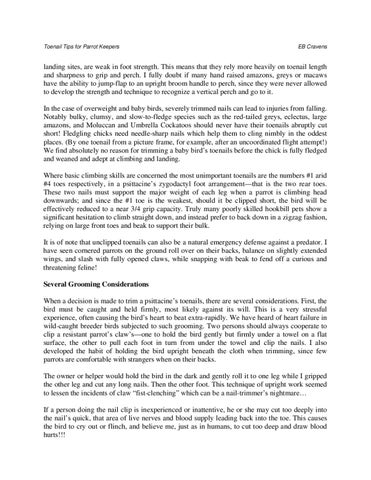Toenail Tips for Parrot Keepers
EB Cravens
landing sites, are weak in foot strength. This means that they rely more heavily on toenail length and sharpness to grip and perch. I fully doubt if many hand raised amazons, greys or macaws have the ability to jump-flap to an upright broom handle to perch, since they were never allowed to develop the strength and technique to recognize a vertical perch and go to it. In the case of overweight and baby birds, severely trimmed nails can lead to injuries from falling. Notably bulky, clumsy, and slow-to-fledge species such as the red-tailed greys, eclectus, large amazons, and Moluccan and Umbrella Cockatoos should never have their toenails abruptly cut short! Fledgling chicks need needle-sharp nails which help them to cling nimbly in the oddest places. (By one toenail from a picture frame, for example, after an uncoordinated flight attempt!) We find absolutely no reason for trimming a baby bird’s toenails before the chick is fully fledged and weaned and adept at climbing and landing. Where basic climbing skills are concerned the most unimportant toenails are the numbers #1 arid #4 toes respectively, in a psittacine’s zygodactyl foot arrangement—that is the two rear toes. These two nails must support the major weight of each leg when a parrot is climbing head downwards; and since the #1 toe is the weakest, should it be clipped short, the bird will be effectively reduced to a near 3/4 grip capacity. Truly many poorly skilled hookbill pets show a significant hesitation to climb straight down, and instead prefer to back down in a zigzag fashion, relying on large front toes and beak to support their bulk. It is of note that unclipped toenails can also be a natural emergency defense against a predator. I have seen cornered parrots on the ground roll over on their backs, balance on slightly extended wings, and slash with fully opened claws, while snapping with beak to fend off a curious and threatening feline! Several Grooming Considerations When a decision is made to trim a psittacine’s toenails, there are several considerations. First, the bird must be caught and held firmly, most likely against its will. This is a very stressful experience, often causing the bird’s heart to beat extra-rapidly. We have heard of heart failure in wild-caught breeder birds subjected to such grooming. Two persons should always cooperate to clip a resistant parrot’s claw’s—one to hold the bird gently but firmly under a towel on a flat surface, the other to pull each foot in turn from under the towel and clip the nails. I also developed the habit of holding the bird upright beneath the cloth when trimming, since few parrots are comfortable with strangers when on their backs. The owner or helper would hold the bird in the dark and gently roll it to one leg while I gripped the other leg and cut any long nails. Then the other foot. This technique of upright work seemed to lessen the incidents of claw “fist-clenching” which can be a nail-trimmer’s nightmare… If a person doing the nail clip is inexperienced or inattentive, he or she may cut too deeply into the nail’s quick, that area of live nerves and blood supply leading back into the toe. This causes the bird to cry out or flinch, and believe me, just as in humans, to cut too deep and draw blood hurts!!!
